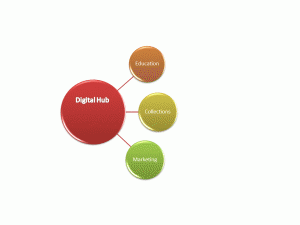John Stack is Head of Digital Transformation and Elena Villaespesa is Digital Analyst at the Tate.
John and Elena spoke with us about digital strategy and evaluation in museums.
During this conversation we focused on the TATE Digital Strategy 2013-2015 and measuring tools used to ensure that the Strategy is accomplishing the established goals.
The Tate Digital Strategy 2013-2015 takes in consideration several areas of the museum: collections and content creation for the digital media at the Tate, fundraising initiatives and marketing of the Tate brand. Digital activity started to show up in different departmental strategy plans and individuals were assuming the content creation for these roles. Taking into consideration this new reality, Stack developed the Digital Strategy to unify and establish important considerations in the development of the Tate’s digital presence. A lot of emphasis can be seen in the development and education of the museum staff regarding the creation of digital content. As each department is interested in developing more digital content, it is important for them and the institution to have the right tools. By teaching the staff to create digital content and allowing them to have creative control, this process becomes more decentralized and open to the public, since many will be able to put their voices “out there”.

Hub and Spoke Model is used to handle the digital activities at the Tate. The Digital Department functions as the hub and the other departments related to a particular project act as the spokes by creating content and managing social media in support of the project and in direct contact with the public.
As part of the Digital Strategy, analytics are being used to monitor performance and engagement. Villaespesa tells us how dashboards have been created for several departments so they can monitor their performance. This allows for openness and the ability to monitor real time the department’s performance and act accordingly. Sentiment Analysis was used in The Tanks project to interpret the public’s reaction and engagement with the activities being held in this new space. Villaespesa was able to draw data from the tone used in tweets as well as the length of the tweets. There are other ways of engaging with the exhibition or content shared by the institution that are more difficult to monitor, but this gives the Tate a good idea as to how the public is reacting. Language also presents another challenge for the analysis of the data since individuals can tweet in other languages besides English. Data queries are being developed to also monitor other languages and we find that some staff members at the Tate Modern are engaging with the public using other languages.
Museums need to start thinking of Digital as part of the overall institutional strategy, according to Stack. The future goal is to not have a separate document that established the Digital Strategy, but to have the digital aspect included in the institutional strategy, making it an unconscious decision by the institution. What do you think? Will we ever reach a point where there will be no need for a Digital Strategy?
I found this interview very interesting particularly for the discussions regarding the integration of digital skills into current titles within museums rather than creating new positions. Stack’s comment that the social media person within the museum has reached the same level of power as the press person really struck a chord with me. I hadn’t realized this before since it seemed to me that social media is such an informal level of communication with the public, and that signified less powerful to me than the more academic publicity realm of press releases and public service announcements. I can see the amazing increase in exposure of the social media outlets of museums versus their ability to gain exposure through the more traditional sources and I can see how this outlet is becoming even more powerful, if it hasn’t already.
I really liked listening to the interview this week John Stack and Elena Villaespesa. I especially was interested about how they would like institutions to put the concept of digital into their overall strategy. I am sure that 10 or maybe 5 years ago, this would not have been thought of as a necessary task, but today we are surrounded and inundated by digital on a daily basis. I thought that it was very interesting how departments now can track their successes and/or see how they could improve by using dashboards as Elena talked about. I have seen things similar to this on the internet that can track how many people have visited the museum that day, etc. I think that this keeps staff on their toes and can regulate what tasks they need to do that day based upon the latest dashboard information. Again, this was not available till very recently to my knowledge, so I would think that at first having this knowledge could be a little daunting, but I believe that eventually staff will find it completely necessary for them to be as productive as possible. It is really neat to see how digital is changing the face of how institutions work on a daily basis and I can’t wait to see what happens in the future concerning this topic.